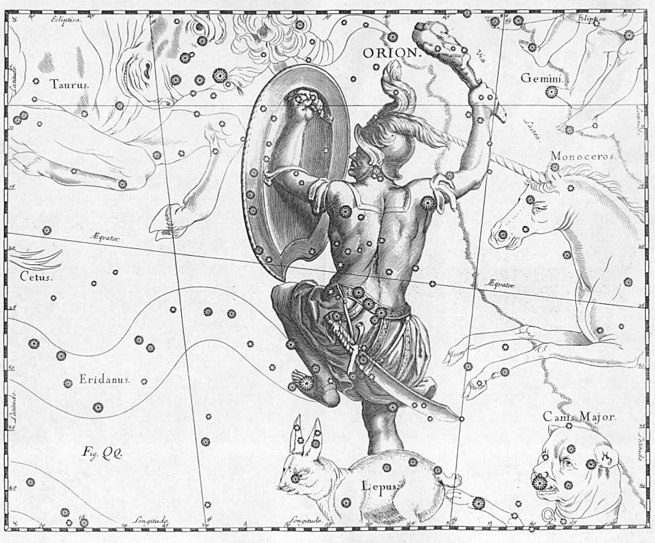
-
Constellation
A constellation is a group of stars that forms an imaginary outline or pattern on the celestial sphere, typically representing an animal, mythological person or creature, a god, or an inanimate object.The origins of the earliest constellations likely go back to prehistory. People used them to relate stories of their beliefs, experiences, creation, or mythology. Different cultures and countries adopted their own constellations, some of which lasted into the early 20th century before today’s constellations were internationally recognized. Adoption of constellations has changed significantly over time. Many have changed in size or shape. Some became popular, only to drop into obscurity. Others were limited to single cultures or nations.
The 48 traditional Western constellations are Greek. They are given in Aratus’ work Phenomena and Ptolemy’s Almagest, though their origin probably predates these works by several centuries. Constellations in the far southern sky were added from the 15th century until the mid-18th century when European explorers began traveling to the Southern Hemisphere. Twelve ancient constellations belong to the zodiac (straddling the ecliptic, which the Sun, Moon, and planets all traverse). The origins of the zodiac remain historically uncertain; its astrological divisions became prominent c. 400 BC in Babylonian or Chaldean astronomy,.
In 1928, the International Astronomical Union (IAU) formally accepted 88 modern constellations, with contiguous boundaries that together cover the entire celestial sphere. Any given point in a celestial coordinate system lies in one of the modern constellations. Some astronomical naming systems include the constellation where a given celestial object is found to convey its approximate location in the sky. The Flamsteed designation of a star, for example, consists of a number and the genitive form of the constellation name.
Other star patterns or groups called asterisms are not constellations per se but are used by observers to navigate the night sky. Asterisms often refer to several stars within a constellation or may share stars with more than one constellation. Examples of asterisms include the Pleiades and Hyades within the constellation Taurus and the False Cross split between the southern constellations Carina and Vela, or Venus’ Mirror in the constellation of Orion.
-
Constellate (verb)
To combine as a cluster.
-
Constellate (verb)
To fit, adorn (as if) with constellations.
-
Constellate (verb)
To (form a) cluster.
-
Constellate (verb)
To shine with united radiance, or one general light.
-
Constellation (noun)
An asterism, an arbitrary formation of stars perceived as a figure or pattern, or a division of the sky including it, especially one officially recognised by astronomers.
-
Constellation (noun)
An image associated with a group of stars.
-
Constellation (noun)
The configuration of planets at a given time (notably of birth), as used for determining a horoscope.
-
Constellation (noun)
A wide, seemingly unlimited assortment.
-
Constellation (noun)
A fleet of satellites of the same purpose such as the set of GPS satellites, or Iridium satcom fleet.
-
Constellation (noun)
A configuration or grouping.
-
Constellation (noun)
A network of connections that exists between people who are in polyamorous relationships, for example between one person, their partner, and that person’s partner.
-
Constellation (noun)
a group of stars forming a recognizable pattern that is traditionally named after its apparent form or identified with a mythological figure.
-
Constellation (noun)
a group of associated or similar people or things
“no two patients ever show exactly the same constellation of symptoms”

